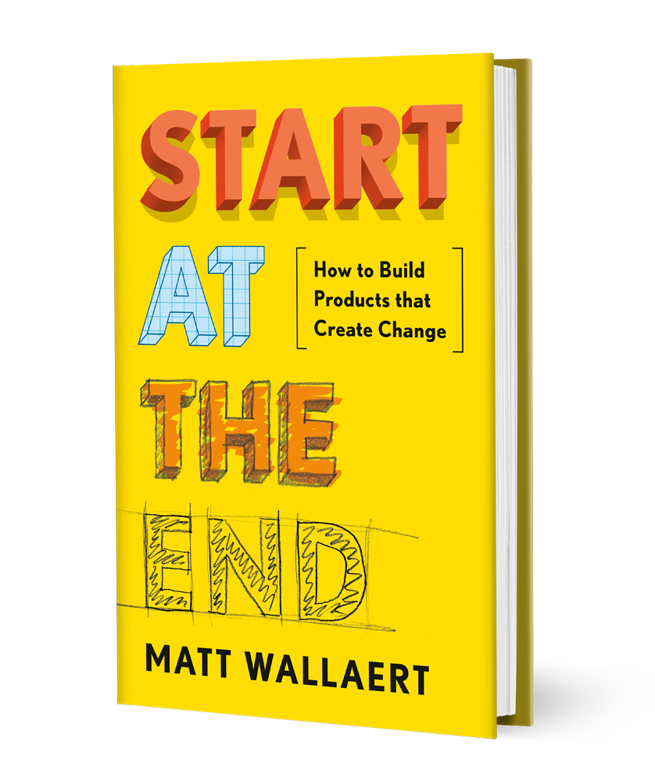I just finished listening to the Audiobook of Start at the End
Book: Start at the End: How to Build Products That Create Change by Matt Wallaert
Links: Website, Audible (Audiobook), Goodreads (reviews), Amazon (buy the book)
I love the behaviour change framework. It seems more practical and useful than the BJ Fogg model for behaviour change.
I’ve also listened to nearly everything by Dr Robert Sapolsky which is great. But this 4 hour audiobook provided a great way of thinking about actually enacting behaviour change from a product perspective. In my case a SaaS startup and ACeS.
NB: I’ve used Claude to summarise the book.
Summary
The “Start at the End” book, focusing on the Intervention Design Process (IDP). Here’s an overview of the key points:
The Intervention Design Process (IDP):
1. Potential Insights and Insight Validation:
– Identify potential insights about behaviors you want to change
– Validate insights through multiple methods (quantitative, qualitative, apocryphal, external)
2. Behavioral Statement:
– Create a clear statement describing the desired behavior change
– Format: “When [population] wants to [motivation], and they [limitations], they will [behavior] (as measured by [data])”
3. Pressure Mapping and Validation:
– Identify promoting pressures (reasons for the behavior) and inhibiting pressures (reasons against the behavior)
– Validate these pressures through research
4. Intervention Design and Selection:
– Design interventions based on the identified pressures
– Select the most promising interventions to test
5. Ethical Check:
– Ensure interventions are ethical and align with users’ motivations
6. Pilot and Pilot Validation:
– Run small-scale tests of interventions
– Validate results, even if not statistically significant
7. Test and Test Validation:
– Run larger-scale tests of successful pilot interventions
– Validate results with more rigorous statistical analysis
8. Scale Decision and Continuous Measurement:
– Decide whether to scale up successful interventions
– Continuously monitor and measure results after scaling
Key Principles:
– Focus on behavior change as the ultimate goal
– Use both promoting and inhibiting pressures
– Validate at every step of the process
– Be willing to iterate and adjust based on results
– Consider ethical implications throughout
The book emphasizes starting with the end goal in mind (the desired behavior change) and working backwards to design effective interventions. It also stresses the importance of using scientific methods to validate insights and interventions, rather than relying on intuition or tradition.Full IDP sentence:
The IDP (Intervention Design Process) uses a specific sentence format for creating behavioral statements. This sentence is a crucial part of the process, as it clearly defines the desired behavior change. Here’s the format of the sentence:
“When [population] wants to [motivation], and they [limitations], they will [behavior] (as measured by [data]).”
Let’s break down each variable:
1. Population: The specific group of people whose behavior you’re trying to change.
2. Motivation: The core reason or desire that drives the behavior.
3. Limitations: The necessary preconditions for the behavior to occur that are outside your control.
4. Behavior: The measurable activity you want people to do when they have the motivation and meet the limitations.
5. Data: How you will quantify and measure that the behavior is occurring.
For example, using Uber as discussed in the book, a behavioral statement might look like this:”When people [population] want to get from Point A to Point B [motivation], and they have a smartphone with connectivity and an electronic form of payment and live in San Francisco [limitations], they will take an Uber [behavior] (as measured by number of rides) [data].”
The book suggests that each of these variables should be binary (yes or no) and measurable. This format helps to clearly define the behavior you’re targeting, the conditions under which it should occur, and how you’ll measure success. It’s an essential tool in the IDP for focusing your efforts and designing effective interventions.
Ethical Check:
The full ethical check sentence from the book is:
If:
– your outcome behavior is not the result of any of the population’s motivations
– or the benefit of your outcome behavior or an intervention to produce it does not outweigh the cost to an alternative motivation
– or you are unwilling to publicly describe and take responsibility for the outcome behavior or intervention
– it is unethical.
This ethical check sentence is designed to ensure that interventions:
1. Align with the motivations of the target population
2. Provide benefits that outweigh any potential costs
3. Are transparent and accountable
The book emphasizes that this ethical check should be applied throughout the Intervention Design Process to ensure that behavior change efforts are ethical and responsible. It’s a crucial step in the IDP that helps prevent unintended negative consequences and promotes transparency in behavior change initiatives.
Inhibiting and promoting pressures
Inhibiting and promoting pressures are key concepts in the Intervention Design Process (IDP) as described in “Start at the End.” Here’s a more detailed explanation:
Promoting Pressures:
– These are factors that make a behavior more likely to occur
– They increase the probability of the desired behavior
– Examples might include convenience, social approval, or personal benefits
Inhibiting Pressures:
– These are factors that make a behavior less likely to occur
– They decrease the probability of the desired behavior
– Examples might include cost, effort required, or social disapproval
Key points about these pressures:
1. Balance: Behavior is determined by the net effect of promoting and inhibiting pressures.
2. Focus on Inhibiting Pressures: The book emphasizes that focusing on reducing inhibiting pressures is often more effective than increasing promoting pressures.
3. Universality: Inhibiting pressures (like cost or availability) tend to apply more universally across a population than promoting pressures.
4. Longevity: Inhibiting pressures often have more longevity and are less likely to change quickly over time compared to promoting pressures.
5. Predictability: Inhibiting pressures are often more predictable and easier to measure than promoting pressures.
6. Prospect Theory: The book mentions that reducing an inhibiting pressure can be more effective than an equivalent increase in promoting pressure, based on the psychological principle that losses hurt more than equivalent gains feel good.
7. Context Dependence: Both types of pressures can change based on context, and what’s a promoting pressure in one situation might be inhibiting in another.
8. Identification: Part of the IDP involves mapping out these pressures for a given behavior and validating them through research.
9. Intervention Design: Once pressures are identified, interventions are designed to either increase promoting pressures or decrease inhibiting pressures to achieve the desired behavior change.
The book suggests that while most traditional approaches focus on increasing promoting pressures (like advertising), there’s often untapped potential in reducing inhibiting pressures to achieve behavior change.

